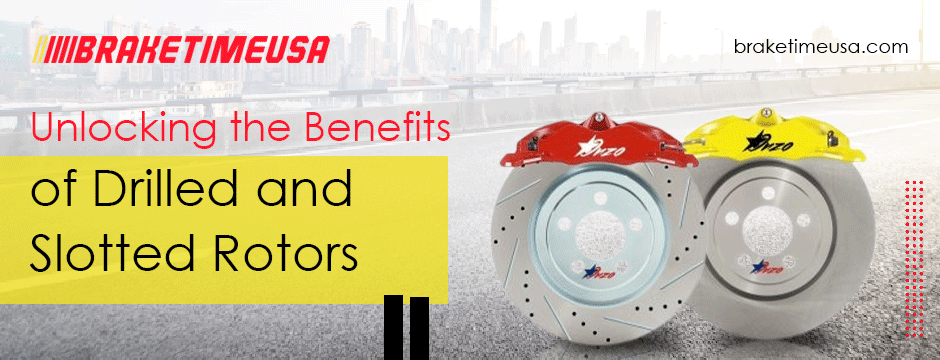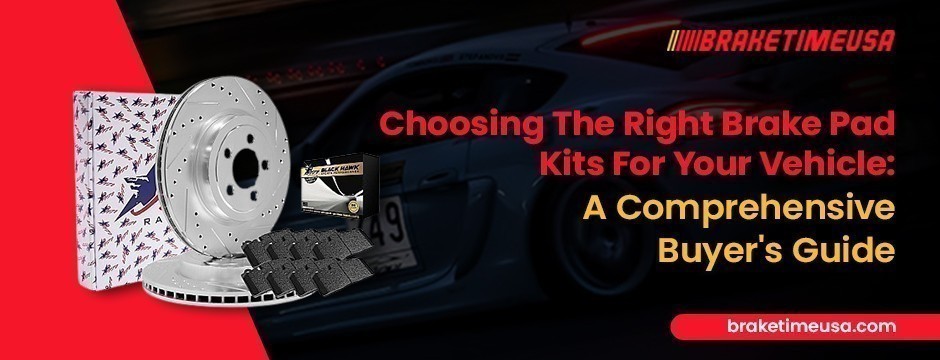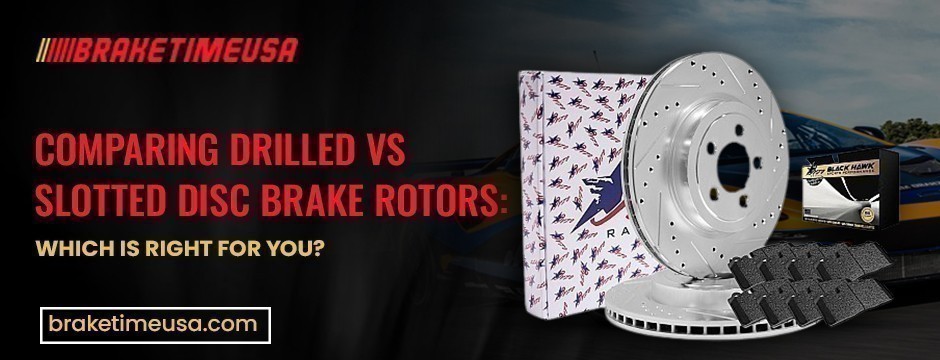Your cart is empty
Subtotal:$0.00
The joy of installing new brake pads and rotors in your vehicle is often accompanied by an unsettling sound – the unmistakable squeak that emanates when you apply the brakes. While this phenomenon can be disconcerting, it's not uncommon, and there are various reasons behind it. In this comprehensive guide, we'll delve into the intricacies of why your brakes squeak after installing new pads and rotors, offering insights into potential causes and actionable solutions. By understanding the underlying factors, you'll be better equipped to address the issue and enjoy a quieter, smoother ride.

1. Breaking In New Brake Pads and Rotors: The excitement of fitting new brake pads and rotors into your vehicle can be accompanied by an unexpected sound – the notorious squeak that occurs when braking. However, this is a common occurrence during the break-in period, a crucial phase where newly installed brake components adjust to each other. This process, known as bedding in, involves the transfer of a thin layer of material from the brake pads onto the rotor surface. While this transfer layer enhances braking performance, it can also be a source of squeaking until a smooth and uniform layer is established.
Solution: The key to addressing squeaking during the break-in period is patience. Manufacturers typically provide recommended break-in procedures that involve gradual and moderate braking for the initial miles. This allows the transfer material to settle and form a consistent layer on the rotor surface, minimizing squeaking. Following the recommended break-in process ensures a smoother interaction between the brake pads and rotors, promoting optimal performance and reducing noise.
Squeaking from brakes after installing new pads and rotors can be attributed to various factors. Understanding these potential causes is crucial for effective troubleshooting and resolution.
2. Surface Irregularities and Glazing: Surface irregularities on either the brake pads or rotors can contribute to squeaking. High spots, uneven wear, or glazed surfaces create conditions that lead to vibrations and noise during the braking process.
Solution: To address surface irregularities, a thorough inspection of both the brake pads and rotors is essential. If irregularities are identified, consider resurfacing or replacing the affected components. Resurfacing involves removing a thin layer of material to create a smoother surface. Additionally, cleaning the rotor surfaces with a suitable cleaner can help eliminate any glazing. This process enhances the contact between the pads and rotors, reducing the likelihood of squeaking.
3. Low-Quality Brake Pads: The quality of the brake pads themselves plays a significant role in determining noise levels. Low-quality or poorly manufactured pads may lack the necessary qualities for a smooth interaction with the rotors, leading to increased friction and noise.
Solution: Investing in high-quality brake pads from reputable manufacturers is a critical solution to minimize noise. Quality pads are designed with materials and formulations that reduce friction and enhance overall braking performance. Choosing brake pads known for their reliability and effectiveness ensures a quieter and more efficient braking system.
4. Inadequate Lubrication: Proper lubrication of contact points between the brake pads, calipers, and shims is essential for preventing squeaks. Inadequate or improper lubrication can result in increased friction and noise during braking.
Solution: Ensuring proper lubrication during the installation of new pads and rotors is crucial. Apply a high-temperature brake lubricant to all contact points, including the back of the brake pads and areas where the pads make contact with the calipers and shims. This lubrication reduces friction, allowing for smoother movement and minimizing noise generation.
Brake squeaking can stem from various factors beyond the initial break-in period and surface irregularities. Exploring these additional contributors provides a comprehensive understanding for effective resolution.
5. Dust and Debris Accumulation: Accumulation of brake dust and debris between the brake pads and rotors is a common cause of noise during braking. As these particles gather, they create friction, leading to squeaking sounds.
Solution: To counteract dust and debris accumulation, regular cleaning of brake components is essential. Use a brake cleaner and a brush to meticulously clean the calipers, brake pads, and rotors. This maintenance practice helps prevent the buildup of particles that can compromise the smooth functioning of the braking system.
6. Caliper Issues: Malfunctioning or sticking calipers can exert uneven pressure on the brake pads, contributing to noise during braking. Uneven pressure leads to uneven wear on the brake pads, causing squeaking sounds.
Solution: A thorough inspection of the calipers is crucial for identifying any issues. Check for proper caliper functioning, ensuring they move freely and apply even pressure to the brake pads. If issues such as uneven wear or sticking are detected, prompt action is necessary. Depending on the severity of the problem, rebuilding or replacing calipers may be required to restore proper functionality and eliminate squeaking.
Understanding the role of dust and debris, as well as potential caliper issues, in brake squeaking provides a holistic approach to addressing this common concern. Regular cleaning practices and vigilant caliper maintenance contribute to a quieter and more efficient braking system.
When faced with squeaky brakes, implementing do-it-yourself (DIY) solutions can be effective in dampening noise and improving overall braking performance.
7. Anti-Squeal Shims or Sprays: Anti-squeal shims or sprays are designed to reduce vibrations and noise by creating a dampening barrier between the brake pads and calipers. When applied to the back of the brake pads, these solutions can minimize squeaking.
Solution: Consider incorporating anti-squeal shims during the brake pad installation process. These shims, placed between the brake pads and calipers, act as a buffer, reducing vibrations and noise. Alternatively, anti-squeal sprays can be applied to the back of the brake pads. These sprays create a layer that helps dampen vibrations, contributing to a quieter braking experience. Both options provide DIY enthusiasts with accessible tools to address squeaky brakes.
8. Check for Loose Components: Loose components within the braking system, such as caliper bolts or hardware, can contribute to brake noise. Vibrations from loose parts may lead to squeaking during braking.
Solution: During the installation or maintenance of brake components, conduct a thorough inspection to ensure all parts are securely fastened. Check for tightness in caliper bolts, hardware, and other relevant components. If any looseness is detected, promptly tighten the bolts or hardware to ensure a secure fit. This simple yet crucial step can significantly reduce the likelihood of brake noise caused by loose components.
Understanding and addressing the reasons behind brake squeaking after installing new pads and rotors is essential for an effective resolution. Whether it's embracing the natural break-in process, mitigating surface irregularities, or implementing DIY solutions, taking proactive measures can lead to quieter and more efficient brakes.
By adhering to proper break-in procedures, investing in quality brake components, and tackling potential causes of squeaking with DIY solutions, car owners can enjoy a smoother and noise-free braking experience. Patience and attention to detail play a crucial role as individuals navigate the path to quieter brakes and a more enjoyable ride.
In the realm of DIY solutions, the use of anti-squeal shims or sprays, along with checking for loose components, empowers car enthusiasts to take control of their braking system's performance. With these measures in place, a quieter and more satisfying driving experience awaits those who prioritize the health and functionality of their vehicle's braking system.
Find out more at Braketime!
 Mar 27, 2024Unlocking the Benefits of Drilled and Slotted Rotors
Mar 27, 2024Unlocking the Benefits of Drilled and Slotted Rotors Mar 22, 2024Choosing The Right Brake Pad Kits For Your Vehicle: A Comprehensive Buyer's Guide
Mar 22, 2024Choosing The Right Brake Pad Kits For Your Vehicle: A Comprehensive Buyer's Guide Mar 18, 2024Exploring Different Types of Rear Brake Rotors
Mar 18, 2024Exploring Different Types of Rear Brake Rotors Mar 6, 2024Comparing Drilled vs. Slotted Disc Brake Rotors: Which Is Right for You?
Mar 6, 2024Comparing Drilled vs. Slotted Disc Brake Rotors: Which Is Right for You?
 Feb 5, 2024Comprehensive Guide on How To Check Brake Pads and Rotors for Optimal Maintenance
Feb 5, 2024Comprehensive Guide on How To Check Brake Pads and Rotors for Optimal Maintenance© 2023 - 2024 Braketimeusa. All rights reserved.
